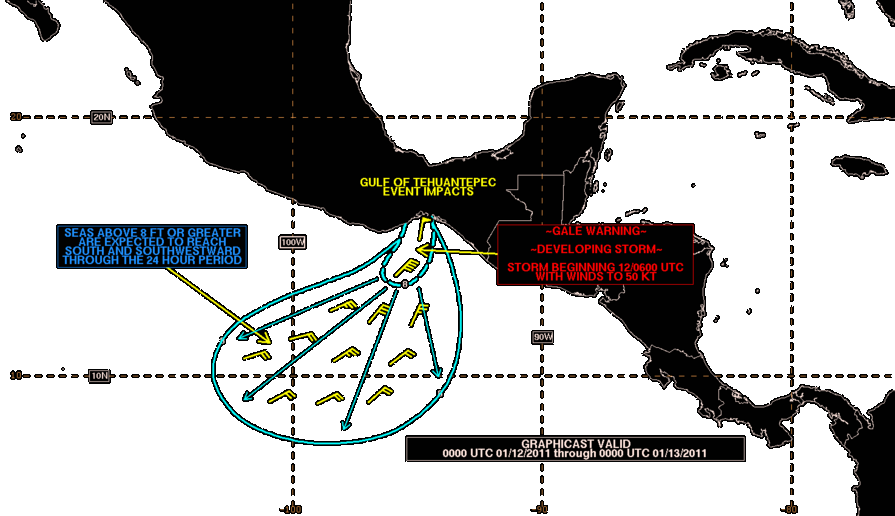|
Tehuano
Tehuantepecer, or Tehuano wind, is a violent mountain-gap wind that travels through the Chivela Pass in southern Mexico, across the Isthmus of Tehuantepec. It is most common between October and February, with a summer minimum in July. It originates from eastern Mexico and the Bay of Campeche as a post-frontal northerly wind, accelerated southward by cold air damming, that crosses the isthmus and blows through the gap between the Mexican and Guatemalan mountains. The term dates back to at least 1929. This wind can reach gale, storm, even hurricane force. The leading edge of its outflow (or cold front) may form rope cloud over the Gulf of Tehuantepec. These winds can be observed on satellite pictures such as scatterometer wind measurements, they influence waves which then propagate as swell and are sometimes observed away (such as in the Galapagos Islands). These strong winds bring cooler sub-surface waters to the surface of the tropical eastern Pacific Ocean and may last from a f ... [...More Info...] [...Related Items...] OR: [Wikipedia] [Google] [Baidu] |
El Niño
El Niño (; ; ) is the warm phase of the El Niño–Southern Oscillation (ENSO) and is associated with a band of warm ocean water that develops in the central and east-central equatorial Pacific (approximately between the International Date Line and 120°W), including the area off the Pacific coast of South America. The ENSO is the cycle of warm and cold sea surface temperature (SST) of the tropical central and eastern Pacific Ocean. El Niño is accompanied by high air pressure in the western Pacific and low air pressure in the eastern Pacific. El Niño phases are known to last close to four years; however, records demonstrate that the cycles have lasted between two and seven years. During the development of El Niño, rainfall develops between September–November. The cool phase of ENSO is es, La Niña, translation=The Girl, with SSTs in the eastern Pacific below average, and air pressure high in the eastern Pacific and low in the western Pacific. The ENSO cycle, including bo ... [...More Info...] [...Related Items...] OR: [Wikipedia] [Google] [Baidu] |
Chivela Pass
The Chivela Pass is a narrow mountain pass in the Sierra Madre Mountains that funnels cooler, drier air from the North American continent, through southern Mexico, into the Pacific. These northeasterly winds, specifically the Tehuano wind, which periodically blows across the Isthmus of Tehuantepec in southern Mexico, and offshore over hundreds of miles of the Pacific Ocean, forcing the upwelling of colder subsurface waters. This strong upwelling brings nutrients from the subsurface layers of the ocean, thereby enhancing the fertility of the offshore waters. This results in strong plankton growth which in turn supports a more bountiful fishery in the region. In extreme circumstances during the winter, truly cold, dense, air occasionally flows from the Bay of Campeche in the Gulf of Mexico through the Chivela Pass into the Gulf of Tehuantepec Gulf of Tehuantepec () is a large body of water on the Pacific coast of the Isthmus of Tehuantepec, southeastern Mexico, at . Many (bu ... [...More Info...] [...Related Items...] OR: [Wikipedia] [Google] [Baidu] |
Isthmus Of Tehuantepec
The Isthmus of Tehuantepec () is an isthmus in Mexico. It represents the shortest distance between the Gulf of Mexico and the Pacific Ocean. Before the opening of the Panama Canal, it was a major overland transport route known simply as the Tehuantepec Route. The name is taken from the town of Santo Domingo Tehuantepec in the state of Oaxaca; this was derived from the Nahuatl term (" jaguar mountain"). Geography The isthmus includes the part of Mexico lying between the 94th and 96th meridians west longitude, or the southeastern parts of Veracruz and Oaxaca, including small areas of Chiapas and Tabasco. The states of Tabasco and Chiapas are east of the isthmus, with Veracruz and Oaxaca on the west. At its narrowest point, the isthmus is across from gulf to gulf, or to the head of Laguna Superior on the Pacific coast. The Sierra Madre del Sur mountain range breaks down at this point into a broad, plateau-like ridge, whose elevation, at the highest point reached by the ... [...More Info...] [...Related Items...] OR: [Wikipedia] [Google] [Baidu] |
Gulf Of Tehuantepec
Gulf of Tehuantepec () is a large body of water on the Pacific coast of the Isthmus of Tehuantepec, southeastern Mexico, at . Many (but not all) Pacific hurricanes form in or near this body of water. A strong, gale-force wind called the Tehuano periodically blows out over the waters of the Gulf of Tehuantepec, inducing strong upwelling of nutrient-rich waters which support abundant sea life. The gulf is in the path of the lowest landform between Mexico and Northern Central America, allowing unhindered wind passage from the Gulf of Mexico, and the Eastern Pacific Ocean. Gulfs of Mexico Tehuantepec Tehuantepec (, in full, Santo Domingo Tehuantepec) is a city and municipality in the southeast of the Mexican state of Oaxaca. It is part of the Tehuantepec District in the west of the Istmo Region. The area was important in pre Hispanic peri ... Landforms of Oaxaca {{Oaxaca-geo-stub ... [...More Info...] [...Related Items...] OR: [Wikipedia] [Google] [Baidu] |
National Oceanic And Atmospheric Administration
The National Oceanic and Atmospheric Administration (abbreviated as NOAA ) is an United States scientific and regulatory agency within the United States Department of Commerce that forecasts weather, monitors oceanic and atmospheric conditions, charts the seas, conducts deep sea exploration, and manages fishing and protection of marine mammals and endangered species in the U.S. exclusive economic zone. Purpose and function NOAA's specific roles include: * ''Supplying Environmental Information Products''. NOAA supplies to its customers and partners information pertaining to the state of the oceans and the atmosphere, such as weather warnings and forecasts via the National Weather Service. NOAA's information services extend as well to climate, ecosystems, and commerce. * ''Providing Environmental Stewardship Services''. NOAA is a steward of U.S. coastal and marine environments. In coordination with federal, state, local, tribal and international authorities, NOAA manages the ... [...More Info...] [...Related Items...] OR: [Wikipedia] [Google] [Baidu] |
Squall Line
A squall line, or more accurately a quasi-linear convective system (QLCS), is a line of thunderstorms, often forming along or ahead of a cold front. In the early 20th century, the term was used as a synonym for cold front (which often are accompanied by abrupt and gusty wind shifts). Linear thunderstorm structures often contain heavy precipitation, hail, frequent lightning, strong straight-line winds, and occasionally tornadoes or waterspouts. Particularly strong straight-line winds can occur where the linear structure forms into the shape of a bow echo. Tornadoes can occur along waves within a line echo wave pattern (LEWP), where mesoscale low-pressure areas are present. Some bow echoes can grow to become derechos as they move swiftly across a large area. On the back edge of the rainband associated with mature squall lines, a wake low can be present, on very rare occasions associated with a heat burst. Theory Polar front theory was developed by Jacob Bjerknes, derived from a dens ... [...More Info...] [...Related Items...] OR: [Wikipedia] [Google] [Baidu] |
Dew Point
The dew point is the temperature to which air must be cooled to become saturated with water vapor, assuming constant air pressure and water content. When cooled below the dew point, moisture capacity is reduced and airborne water vapor will condense to form liquid water known as dew. When this occurs via contact with a colder surface, dew will form on that surface. The dew point is affected by humidity. When there is more moisture in the air, the dew point is higher. When the temperature is below the freezing point of water, the dew point is called the frost point, as frost is formed via deposition rather than condensation. In liquids, the analog to the dew point is the cloud point. Humidity If all the other factors influencing humidity remain constant, at ground level the relative humidity rises as the temperature falls; this is because less vapor is needed to saturate the air. In normal conditions, the dew point temperature will not be greater than the air temperature, sinc ... [...More Info...] [...Related Items...] OR: [Wikipedia] [Google] [Baidu] |
Temperature
Temperature is a physical quantity that expresses quantitatively the perceptions of hotness and coldness. Temperature is measured with a thermometer. Thermometers are calibrated in various temperature scales that historically have relied on various reference points and thermometric substances for definition. The most common scales are the Celsius scale with the unit symbol °C (formerly called ''centigrade''), the Fahrenheit scale (°F), and the Kelvin scale (K), the latter being used predominantly for scientific purposes. The kelvin is one of the seven base units in the International System of Units (SI). Absolute zero, i.e., zero kelvin or −273.15 °C, is the lowest point in the thermodynamic temperature scale. Experimentally, it can be approached very closely but not actually reached, as recognized in the third law of thermodynamics. It would be impossible to extract energy as heat from a body at that temperature. Temperature is important in all fields of natur ... [...More Info...] [...Related Items...] OR: [Wikipedia] [Google] [Baidu] |
United States Naval Research Laboratory
The United States Naval Research Laboratory (NRL) is the corporate research laboratory for the United States Navy and the United States Marine Corps. It was founded in 1923 and conducts basic scientific research, applied research, technological development and prototyping. The laboratory's specialties include plasma physics, space physics, materials science, and tactical electronic warfare. NRL is one of the first US government scientific R&D laboratories, having opened in 1923 at the instigation of Thomas Edison, and is currently under the Office of Naval Research. As of 2016, NRL was a United States Navy Working Capital Fund, Navy Working Capital Fund activity, which means it is not a line-item in the US Federal Budget. Instead of direct funding from Congress, all costs, including overhead, were recovered through sponsor-funded research projects. NRL's research expenditures were approximately $1 billion per year. Research The Naval Research Laboratory conducts a wide v ... [...More Info...] [...Related Items...] OR: [Wikipedia] [Google] [Baidu] |
Intertropical Convergence Zone
The Intertropical Convergence Zone (ITCZ ), known by sailors as the doldrums or the calms because of its monotonous windless weather, is the area where the northeast and the southeast trade winds converge. It encircles Earth near the thermal equator though its specific position varies seasonally. When it lies near the geographic Equator, it is called the near-equatorial trough. Where the ITCZ is drawn into and merges with a monsoonal circulation, it is sometimes referred to as a monsoon trough, a usage that is more common in Australia and parts of Asia. Meteorology The ITCZ was originally identified from the 1920s to the 1940s as the ''Intertropical Front'' (''ITF''), but after the recognition in the 1940s and the 1950s of the significance of wind field convergence in tropical weather production, the term ''Intertropical Convergence Zone'' (''ITCZ'') was then applied. The ITCZ appears as a band of clouds, usually thunderstorms, that encircle the globe near the Equator. In the ... [...More Info...] [...Related Items...] OR: [Wikipedia] [Google] [Baidu] |







